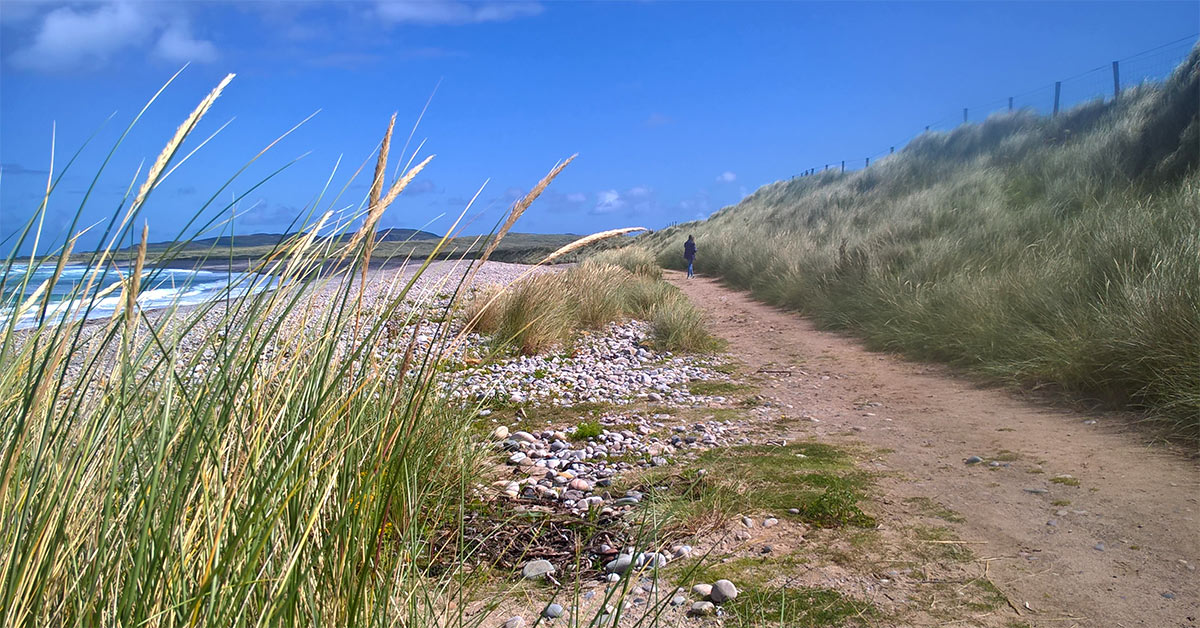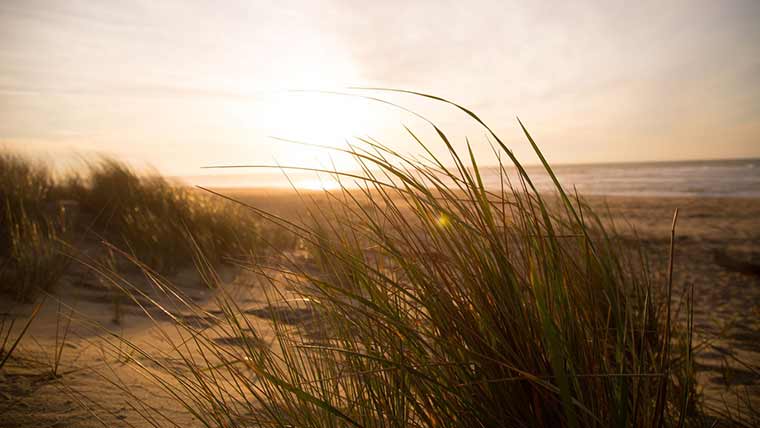Dune management involves restoring eroded areas and stabilising others using vegetation and fencing. The idea is to help, not obstruct the dune-forming processes to conserve the dune ecosystem. Access work, building boardwalks to steer people away from sensitive sites, is also important.
Hands-on techniques for managing sand dunes
Dune Stabilisation
The most useful species to plant on bare sand and to initiate new dune development are the three natural dune-forming perennial grasses: sand couchgrass, sea lyme grass and marram.
Digging Up
Marram grass (Ammophila avenaria) is the most common plant used in dune restoration.
Young plants (those with fibrous roots) transplant better than older ones. They are best obtained from the downwind side of mobile dunes.
Don’t denude an area, but collect only one or two clumps per square metre.
Loosen a clump of marram with a spade or a fork, then pull the plants up by hand if possible. Get as much rhizome as possible with each plant, preferably 30cm or more. Shake the plants gently to get rid of excess sand. Tread back the disturbed soil to reduce erosion.
Keep the roots covered and out of the sun – if they dry out, the plant will die.
Transporting
The easiest things to carry the plants in are clean old plastic sacks. Put all the plants into the bag the same way round. Make sure the plants are shaded and moist. Heel them in if they need to be stored for more than a few hours.
Planting
A sharp dibber is the best tool for planting. Bare hands are good in dry sand.
Make a hole deep enough to get at least 15cm of root into damp sand, whilst planting as near as possible to the depth the grass was originally growing at.
Where is is uncertain how healthy an individual plant is, plant a couple in each hole.
Replace the sand firmly and make sure all roots are thoroughly covered.
Tug the plants to check that they are firmly planted.
Judge space according to the availability of plants. 45cm between plants is adequate.
On exposed sites, trim the growth to about 10cm so they are not loosened by the wind.
To plant a slope, start at the top and work downwards to avoid trampling on what you have just planted.
Plant the whole of a dune face, not just part of it, otherwise erosion problems will be encountered.
Don’t plant within 2m of the high water mark because marram has low salt tolerance. Below this height sand couchgrass (Agropyron junceiforme) or lyme grass (Elymus arenarius) can be used.
Dune Fencing
For details of fencing techniques, see How to Build Fences [coming soon]. The following are special types of fencing adapted for sandy areas.
Access Control Fences
Where sand build-up is to be avoided, post and wire fencing is the easiest and cheapest.
Straining posts must be very well made. Dig the hole quickly and put the sand in one heap to reduce drying out.
Sand does not compress much with tamping, so replace the sand in layers about 5cm thick and water each layer until it is thoroughly moist.
Do not strain wire more than is absolutely necessary.
Where access control is to be combined with sand trapping, chestnut paling or dutch fencing reinforced with strained wire are best.
Sand Trap Fences
There are many different designs, mainly determined by the availability of materials. When using branches, ensure they are dead otherwise they may take root.
The fence should stand 0.7m to 1.2m high and have a porosity (proportion of holes) of about 50%. To decide on fence alignment, take note of the prevailing wind direction. It should normally run at right angles to the wind.
An abrupt end to a sand trap fence can cause scouring round the end. A short section of dutch fence will avoid this.
Boardwalks
The design depends on ground conditions and the materials available. Where the path may need to be relocated periodically, use duckboards – wooden slats attached to rails. Avoid running boardwalks or duckboards up steep slopes.
Dune Thatching
Dune thatching acts as a low wind barrier to trap sand and protect newly planted vegetation. It is only effective by itself in small areas and should generally be combined with marram grass planting.
Work from the top of a slope downwards. The top branches should not project above the top of the slope, or the wind will catch them.
Follow contours closely and keep the thatching an even thickness, since any projecting branches will catch the wind.
Push the branches well into the sand. When thatching a blowout, work down in concentric circles and finish by blocking the entrance.
Thatching A Blowout
Where public pressure is intense, run occasional wires across the thatching, staked down at either end, to hold the brush in place.
Season
Varies according to the work. Marram transplanting – November to April, other jobs at any time.
Site visit
Visit the work site in advance to gain a clear idea of what you will be doing on the day.
Assess the suitability of the project for the group you will be leading and the time available.
Undertake a risk assessment for both project and site.
Tools and equipment
Depending on the size of the team adjust the quantity of equipment taken to the site.
Check the tools are in good condition before using them.
- First aid kit
- Appropriate protective gloves
- Shovels
- Digging spades
- Trenching spades
- Mattock
- Fork
- Dibber
- Wheelbarrow
- Rope (for dragging brushwood)
- Book of tide tables
- Buckets
- Plastic sacks
- Old fish netting
Ensure all team members are wearing appropriate footwear and clothing and issue the specified safety equipment.
Introduction
Introduce the site, the work and the reasons for doing it.
Walk around the site explaining what work will be undertaken. Identify potential hazards and explain how to work safely around them.
Demonstrate Tool Use
Demonstrate and explain the safe use, carrying and onsite care of the tools before starting work.
Demonstrate work techniques
Demonstrate all new work techniques as you come to them. This will save mistakes and avoid accidents.
Demonstrate the correct lifting technique (bending the knee and keeping the back straight so that the leg muscles are used and the back is not strained).
Organisation of team
Divide the team into pairs, teaming beginners with more experienced volunteers.
The most efficient way to work is to form a production line, each team doing a specific job, eg hole digging; post-driving; wire straining etc. Swap pairs around at tea or lunch breaks.
The leader should check, assist and encourage people and ensure work standards are being maintained.
Boardwalks are best constructed by small teams of two to four people, so it is best to have other types of work going on at the same time.


